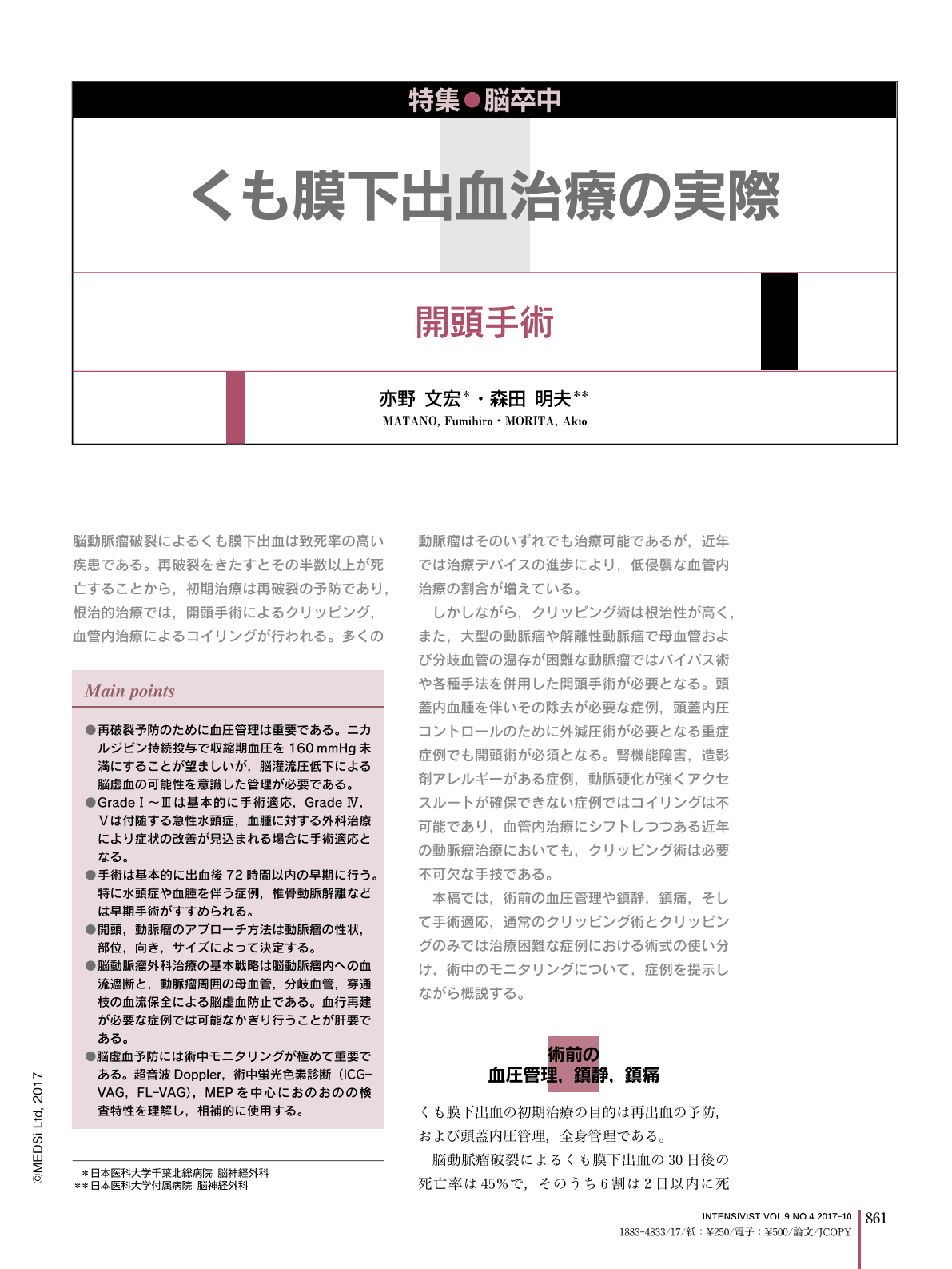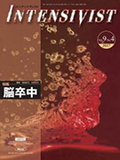Japanese
English
- 有料閲覧
- Abstract 文献概要
- 1ページ目 Look Inside
- 参考文献 Reference
脳動脈瘤破裂によるくも膜下出血は致死率の高い疾患である。再破裂をきたすとその半数以上が死亡することから,初期治療は再破裂の予防であり,根治的治療では,開頭手術によるクリッピング,血管内治療によるコイリングが行われる。多くの動脈瘤はそのいずれでも治療可能であるが,近年では治療デバイスの進歩により,低侵襲な血管内治療の割合が増えている。
しかしながら,クリッピング術は根治性が高く,また,大型の動脈瘤や解離性動脈瘤で母血管および分岐血管の温存が困難な動脈瘤ではバイパス術や各種手法を併用した開頭手術が必要となる。頭蓋内血腫を伴いその除去が必要な症例,頭蓋内圧コントロールのために外減圧術が必要となる重症症例でも開頭術が必須となる。腎機能障害,造影剤アレルギーがある症例,動脈硬化が強くアクセスルートが確保できない症例ではコイリングは不可能であり,血管内治療にシフトしつつある近年の動脈瘤治療においても,クリッピング術は必要不可欠な手技である。
本稿では,術前の血圧管理や鎮静,鎮痛,そして手術適応,通常のクリッピング術とクリッピングのみでは治療困難な症例における術式の使い分け,術中のモニタリングについて,症例を提示しながら概説する。
Main points
●再破裂予防のために血圧管理は重要である。ニカルジピン持続投与で収縮期血圧を160mmHg未満にすることが望ましいが,脳灌流圧低下による脳虚血の可能性を意識した管理が必要である。
●GradeⅠ〜Ⅲは基本的に手術適応,Grade Ⅳ,Ⅴは付随する急性水頭症,血腫に対する外科治療により症状の改善が見込まれる場合に手術適応となる。
●手術は基本的に出血後72時間以内の早期に行う。特に水頭症や血腫を伴う症例,椎骨動脈解離などは早期手術がすすめられる。
●開頭,動脈瘤のアプローチ方法は動脈瘤の性状,部位,向き,サイズによって決定する。
●脳動脈瘤外科治療の基本戦略は脳動脈瘤内への血流遮断と,動脈瘤周囲の母血管,分岐血管,穿通枝の血流保全による脳虚血防止である。血行再建が必要な症例では可能なかぎり行うことが肝要である。
●脳虚血予防には術中モニタリングが極めて重要である。超音波Doppler,術中蛍光色素診断(ICG-VAG,FL-VAG),MEPを中心におのおのの検査特性を理解し,相補的に使用する。
Subarachnoid hemorrhage due to ruptured intracranial aneurysms is associated with significant morbidity and mortality. Re-bleeding from ruptured intracranial aneurysms further diminishes outcomes, and the mortality exceeds 50%. To prevent re-bleeding, early interventions, including surgical clipping or endovascular coiling of aneurysms, are justified. Although a majority of aneurysms can be treated with either technique, the indication for endovascular treatment is expanding due to its noninvasive nature, improvements in available devices and accumulation of supporting evidence. However, surgical clipping of aneurysms has the advantage of excellent curability and technical superiority for giant aneurysms and dissecting aneurysms requiring revascularization with a bypass or other intracranial techniques. Craniotomy is also indicated for patients with an intracranial hematoma and those with a significant increase in intracranial pressure. Endovascular coiling of aneurysms is avoided in patients with significant renal dysfunction, contrast-induced allergies or severe atherosclerotic disease. Therefore, clipping of aneurysms is still an essential technique, which cannot be completely replaced by endovascular procedures. In this article, the perioperative management of patients with intracranial aneurysms including preoperative blood pressure control, sedation and analgesia, indications for surgery, technical strategies for clipping in both simple and difficult cases, and intraoperative monitoring will be discussed from a practical point of view.

Copyright © 2017, MEDICAL SCIENCES INTERNATIONAL, LTD. All rights reserved.


